
Common Snake Species in Providence
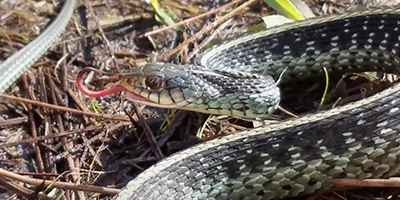 Eastern Garter Snake:
The eastern garter snake (Thamnophis sirtalis) is a widespread species found throughout North America. They like moist, grassy environments but can be found away from water. They can be found in populated areas where there is cover (debris, boards, logs, vegetation). They are not venomous.
Eastern Garter Snake:
The eastern garter snake (Thamnophis sirtalis) is a widespread species found throughout North America. They like moist, grassy environments but can be found away from water. They can be found in populated areas where there is cover (debris, boards, logs, vegetation). They are not venomous. Adult eastern garter snakes are typically 20-28 inches in length. They usually have three yellow longitudinal stripes down a dark body. A few have a checkered pattern with light stripes or reddish body color. They are active both day and night and throughout the year. They are common and not a protected species.
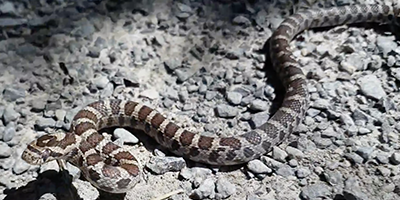 Eastern Milk Snake:
The eastern milk snake (Lampropeltis trangulum) is a nearly universal species that can be found from Canada, throughout much of the United States, and into Mexico and Ecuador. They are typically found in fields, woodlands, and rocky hillsides but like dark places where they can take cover, such as trash piles and basements. They are not venomous and even are kept as pets.
Eastern Milk Snake:
The eastern milk snake (Lampropeltis trangulum) is a nearly universal species that can be found from Canada, throughout much of the United States, and into Mexico and Ecuador. They are typically found in fields, woodlands, and rocky hillsides but like dark places where they can take cover, such as trash piles and basements. They are not venomous and even are kept as pets. Eastern milk snakes have a distinctive pattern of light to reddish-brown bands that are bordered by a thin black line on a gray to light brown to red background. They are often mistaken for the more dangerous copperhead snake. Adult eastern milk snakes average 24 to 52 inches in length. They are primarily nocturnal.
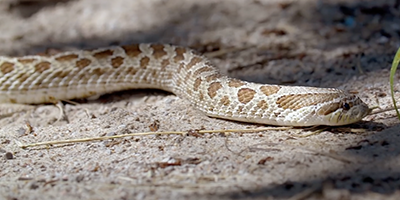 Hognose Snake:
The hognose snake (Heterodon platirhinos) is a common species of snake in the United States that can be found from as far north as southern Minnesota and New Hampshire, to Kanas, and as far south as Florida and Texas. They like areas with sandy soil and woodlands. In urban settings, it is attracted to piles of debris and construction sites with exposed soil. They prey mainly on amphibians, such as toads, and have fangs with an amphibian-specific venom that is not deadly or even harmful to humans. They are considered non-venomous.
Hognose Snake:
The hognose snake (Heterodon platirhinos) is a common species of snake in the United States that can be found from as far north as southern Minnesota and New Hampshire, to Kanas, and as far south as Florida and Texas. They like areas with sandy soil and woodlands. In urban settings, it is attracted to piles of debris and construction sites with exposed soil. They prey mainly on amphibians, such as toads, and have fangs with an amphibian-specific venom that is not deadly or even harmful to humans. They are considered non-venomous.The hognose snake gets its name from its most distinctive feature- an upturned nose that is useful for digging in sandy soil. They come in a wide variety of colors and can be a mix of red, green, orange, brown, yellow, grey, or black. They also have a wide variety of markings. They tend to have lighter bellies that are tan, cream-colored, or grey. The average adult is 28 inches and females tend to be larger than males.
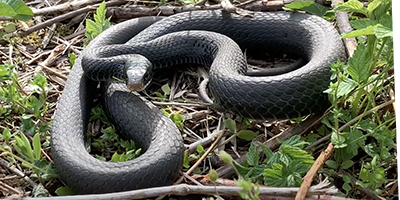 Northern Black Racer:
The northern black racer (Coluber C. Constrictor) is a common snake that is found from southern Maine down the eastern seaboard to Georgia, and west in Ohio down through Alabama and parts of Tennessee. It shows a preference for lightly wooded habitats, including meadows, fields, powerline rights-of-way, and the transitional spaces between forests and fields. They are not venomous.
Northern Black Racer:
The northern black racer (Coluber C. Constrictor) is a common snake that is found from southern Maine down the eastern seaboard to Georgia, and west in Ohio down through Alabama and parts of Tennessee. It shows a preference for lightly wooded habitats, including meadows, fields, powerline rights-of-way, and the transitional spaces between forests and fields. They are not venomous.The adult northern black racer has a solid black coloring with smooth scales that give it a dramatic “matte” finish. It has a white chin and a blue-tinged belly. Juveniles have a light-grey body with dark-brown blotches that darken with age. Adults can range in length from 33 to 65 inches. They hunt in the daytime and prey on toads, frogs, small birds, small mammals (like chipmunks and shrews), rodents, and insects.
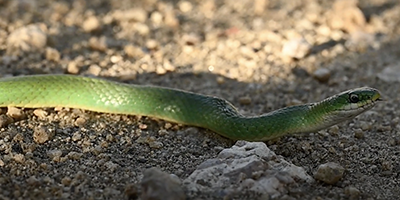 Smooth Green Snake:
The smooth green snake (Opheodrys Vernalis) is a common snake that is found in a large geographic area of southern Canada, and throughout the eastern seaboard of the United States down to Virginia, as well as west to Wyoming, Colorado, Kansas, Mississippi, Texas, and down to northern Mexico. It makes its home in habitats such as marshes, meadows, open woods, and streams. It is particularly fond of open areas. They are not venomous.
Smooth Green Snake:
The smooth green snake (Opheodrys Vernalis) is a common snake that is found in a large geographic area of southern Canada, and throughout the eastern seaboard of the United States down to Virginia, as well as west to Wyoming, Colorado, Kansas, Mississippi, Texas, and down to northern Mexico. It makes its home in habitats such as marshes, meadows, open woods, and streams. It is particularly fond of open areas. They are not venomous. The smooth green snake lives up to its name, being thin, with smooth green scales. It is bright green with a yellow or white belly. Juveniles are typically olive-green, blue-grey, or brown until they shed their skin and take on the characteristic bright green. They enjoy eating insects, spiders, ants, moths, snails, slugs, and caterpillars. Their habitat is threatened by human activities such as farming, logging, off-road vehicles, pesticide use, and residential development.